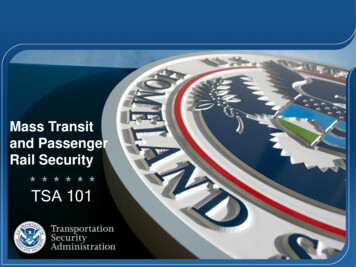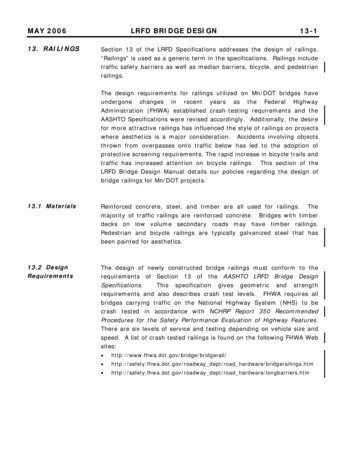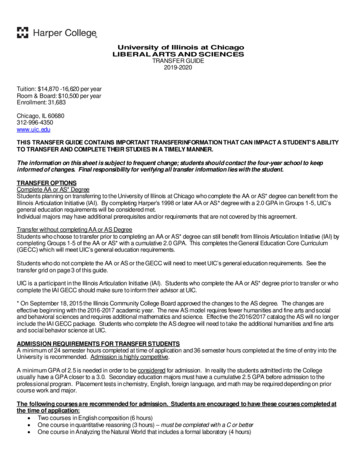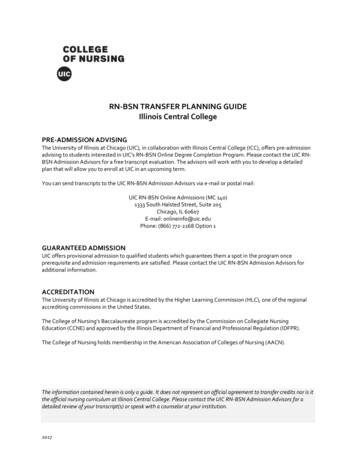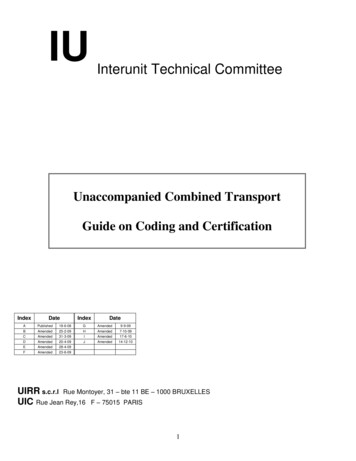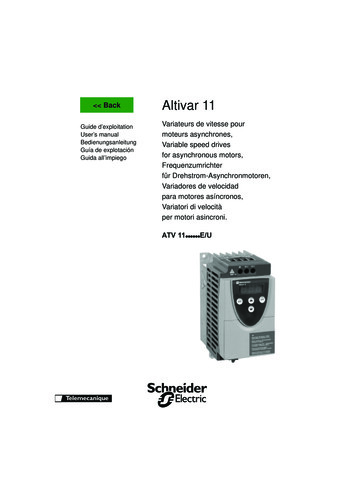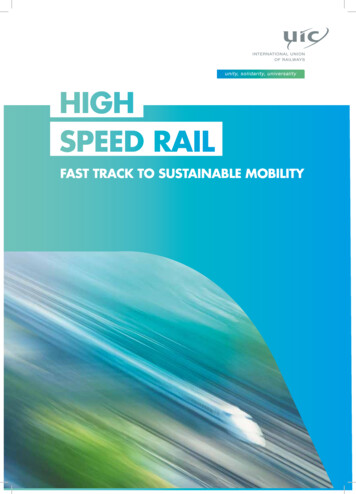
Transcription
HIGHSPEED RAILFAST TRACK TO SUSTAINABLE MOBILITY
233HIGH SPEED RAIL GENERAL OVERVIEWSUMMARY3HIGH SPEED RAIL GENERAL OVERVIEW4-5HIGH SPEED RAIL HISTORY6-7HIGH SPEED RAIL PRINCIPLES8-11HIGH SPEED RAIL AND SUSTAINABILITY12-13TECHNICAL ASPECTS - INFRASTRUCTURE14-15TECHNICAL ASPECTS - ROLLING STOCK16-19TECHNICAL ASPECTS - OPERATIONS20-21STATIONS, HIGH SPEED RAIL AND THE CITY22-23HIGH SPEED RAIL AND THE CUSTOMERS24-25ECONOMY AND FINANCES FOR HIGH SPEED RAIL26-29HIGH SPEED RAIL AROUND THE WORLD30-33FUNDAMENTAL VALUES OF HIGH SPEED RAIL34-37HIGH SPEED RAIL TOWARDS THE FUTURE38-39HIGH SPEED RAIL AT UIC40FOREWORDCREDITSHigh speed rail encompasses a complex reality involving many technical aspects such asinfrastructure, rolling stock and operations,as well as strategic and cross-sector issuesincluding human factors and financial, commercial, and managerial components.However high speed rail is not always wellunderstood as a whole transport system andits performance is not fully taken advantageof, which limits the potential developmentof high speed, the development of “classicrail”, and all other transport modes.In addition, a high speed rail system combines all these various elements by usingthe highest level of technology and the mostadvanced conception for each of them.For a long time UIC has been paying particular attention to high speed and has prioritised among other objectives the communication and dissemination of high speedperformances, characteristics and potentialapplications.High speed is a rapidly expanding newtransport mode and is often described asthe “transport mode of the future”. This isdue to the three main and very importantcharacteristics offered to customers andsociety: safety, capacity (“within velocity”),and sustainability (in particular with respectto the environment).This brochure, published every two years onthe occasion of the World Congress on HighSpeed Rail (organised by UIC together witha national high speed member) intends toshed some light on the principles and possibilities of high speed rail, in view of betterand more logical development.WHAT DOES HIGH SPEED RAIL MEAN ?The high speed criteria used by UIC is for operations of at least 250km/h.Of course, these technical criteria should not mask the performance as perceived by customers in terms of travel time, frequency, comfort, and price thatis really important.
5HIGH SPEED RAIL HISTORYHIGH SPEED RAILHISTORYAfter the big success of the Shinkansenoperation, technical progress in several European countries, particularlyFrance, Germany, Italy and UK, developed new technologies and innovations aimed to establish the basis forthe «passenger railway of the future».Despite an unknown future (Concorde,political opposition, 1973 first petroleum crisis, etc.) and even if severalother existing or new transport modes intended to compete with theclassic railway concept, finally SNCF,the French national railway company,started the operation of the first highspeed line between Paris to Lyons on27 September 1981, at a maximumspeed of 260 km/h.The European HSR was born, but in contrastto the Shinkansen concept, the new EuropeanHSR was fully compatible with existing railwaysand this largely conditioned the further development of the system in the Old Continent.F R OM B IRT H OF RAI WAYS TO HSR19TH - 20THCENTURYThe history of railways is a history of speed.Since the origin of railways in Europe during the Industrial Revolution atthe beginning of the 19th Century, the speed of passenger trains was anessential argument to compete, not necessarily with other transport modes(the railway in itself changed the scale of time for passenger travel) butamong the different companies. The speed on rails also constituted anevidence of technological development of the most advanced countriesat that time.It’s easy to imagine that the 50 km/h reached by the impressive “Rocket”locomotive from George Stephenson in 1829 represented a true high speedconsideration for railways since the beginning.And very soon railways reached even much more impressive speeds:100 km/h before 1850, 130 km/h in 1854, and even 200 km/h at the beginningof the 20th century. In any case, these were just speed records. The maximumspeed in revenue operation was much more modest but neverthelessimportant, reaching 180 km/h as the top speed and 135 km/h as the average speed betweentwo cities in the 1930s, with steam, electric or diesel power.But the appearance on stage of other transport modes, aviation (offering more speed) andprivate cars (offering point to point travels in privacy and forgetting frequency), forced passengerrailways to use their best arguments to compete.HSR SERVICES SPREADING IN THE WORLDTHE BI RTH O FSHI NKANSEN1964After some significant speed records in Europe (Germany, Italy,UK and specially France, 331 km/hin 1955), the world was surprisedwhen, on 1 October 1964, Japanesenational railways started the operation of a fully brand new 515 kmstandard gauge line (1435 mm, apartfrom conventional lines previouslybuilt in Japan, in meter gauge), the TokaidoShinkansen, from Tokyo Central to Shin Osaka.This line was built to provide capacity tothe new transport system necessary for theimpressively rapid growth of the Japaneseeconomy. JNR president Shinji Sogo and VicePresident for Engineering Hideo Shima promoted the concept of not only a new line, buta new transport system, called to be extendedlater to the rest of the country and to becomethe backbone of passenger transport for thefuture generations of citizens in Japan.The Tokaido Shinkansen was designed tooperate at 210 km/h (later increased), broadloading gauge, electric motor units poweredat 25 kV AC, Automatic Train Control (ATC),Centralised Traffic Control (CTC) and othermodern improvements.High speed rail (HSR) was born.Once again, after the big successof the TGV, each European countrylooked for the new generation ofcompetitive long and medium distance passenger rail services, in somecases by developing its new technology and in others by importing.Joining the group of countries offering high speed rail services in Europewere Italy and Germany in 1988, Spainin 1992, Belgium in 1997, the UnitedKingdom in 2003 and the Netherlandsin 2009.In the meantime, some similar casesappeared in other countries and regions, such as China in 2003 (evenif the big development came later,in 2008), South Korea in 2004, TaiwanRailway High Speed Corporationin 2007 and Turkey in 2009.1830190319641981198819891992199720032004The “Rocket” locomotive by GeorgeStephensonreaches 50 km/hSiemens & AEGelectric railcarobtains 210 km/h1st October, thefirst high speedsystem in the world, Shinkansenstarts in JapanThe TGV, firstEuropean highspeed train,operates in Franceat 260 km/h“Pendolino” in Italyand ICE in GermanyThe TGV“Atlantique”,first train to operate regularly at300 km/hAVE in SpainHigh speedin BelgiumHS1 in the UnitedKingdomKTX in SouthKoreaFROM YESTERDAY TO TOMORROWTHE HSR OF THE FUTUREA new dimension and a new perspective for HSR started in China on 1August 2008. The 120 km high speed line between Beijing to Tianjin represents just the first step in a huge development to transform the wayof travelling for the most populated country in the world. Since 2008,China has implemented almost 20,000 kilometres of new high speed linesand thanks to an enormous fleet of more than 1,500 train sets, carries800 million passengers per year (2014 and growing), more than the halfof the total high speed traffic in the world.And following the example led by China, new high speed systems are underdevelopment around the world: Morocco, Saudi Arabia, USA, etc.Accordingly with 2015 expectations, and in spite of the developmentof other transport modes (for example the Maglev, automatic driving cars,improvements in aviation, etc.), by 2030-2035, the extension of the world HSR network could reach more than 80,000 kilometres, representingan important challenge for operators, industry, authorities, etc.High speed must be continuously developed and performed in order to continue to be presentin passenger transport in the next 50 years (or more).2009 ANDBEYOND1964 - 1981THE BIRTH OF TGV1981- 20094200720072008574.8km/h world Taiwan High Speed CRH in Chinaspeed record inRail CorporationFrance20092015High speed inthe Netherlandsand in TurkeyHigh speed linesin the worldextends overalmost 30,000kilometres
67HIGH SPEED RAIL PRINCIPLESHIGH SPEED RAILPRINCIPLES19641 ST OCTOBER: WORLD’S FIRST HIGH SPEED TRAIN SERVICE FROM TOKYO TO OSAKA29,792 KM OF HIGH SPEED LINES IN THE WORLD (1 APRIL 2015)3,603HIGH SPEED TRAIN SETS IN OPERATION (APRIL 2015)574.8 KM/H1 S T P R INC IP LE : H I GH SPEED RAI L I S A SYSTEMHigh speed railways are very complex systemswhich combine the state of the art in manydifferent fields:Infrastructure (including civil engineering works, track, signalling, power supplyand catenary, etc.)Stations (location, functional design,equipment)Rolling stock (technology, comfort, design)Operations (design and planning,control, rules, quality management) Maintenance strategy and corresponding facilitiesFinancingMarketingManagementLegal issues, regulations.It is essential that all these componentscontribute to the quantitative and qualitative global technical performance andcommercial attractiveness. None of themis to be neglected neither in itself norin conjunction with the others. From thecustomer viewpoint, the true speed is thecomparison between the time spent buyinga ticket, accessing to and entering the station or waiting for a taxi on arrival, with thedoor-to-door distance and not only thetime saved by using a high speed train asa result of high-level technology and significant investments.2 N D P RINC IP LE : HI GH SPEED RAI L SYSTEMSAR E ( E QU A L B UT ) DI FFERENT EVERYWHEREHigh speed systems depend on how all theircomponents are designed and interact.The final system obtained (in terms of costand performances) can be very differentfrom one country to another dependingon, among other things, commercialapproach, operation criteria and costmanagement.3RD PRINCIPLE: HIGH SPEED RAIL SYSTEMS MEANS CAPACITYAccordingly with the main characteristic ofrailway, high speed rail is synonym of capacity and sustainability and consequently,will be more adequate when more potentialdemand of traffic will serve. Also, capacity re-quires accessibility, complementarities andmultimodal approach. The coherence in theapplication of all these three principles is essential in order to obtain the success in theapplication of this modality of rail transport.WORLD SPEED RECORD (FRANCE 2007)320 KM/HMAXIMUM SPEED IN REVENUE OPERATION (APRIL 2015)1,600 MILLIONPASSENGERS PER YEAR CARRIED BY HIGH SPEED TRAINS IN THE WORLD8 00 MILLION PASSENGERS PER YEAR IN CHINA355 MILLION PASSENGERS PER YEAR IN JAPAN130 MILLION PASSENGERS PER YEAR IN FRANCE315 M ILLION PASSENGERS PER YEAR IN THE REST OF THE WORLDMODAL SPLIT OBTAINED BY HIGH SPEED TRAINS IN RELATION TO AIR TRANSPORT80% WHEN TRAVEL TIME BY TRAIN IS LESS THAN 2.5 HOURST EC H N O LO GY R EQ UIR EMEN T SFrom a strictly technical point of view, operating high speed rail systems require:Special TrainsHigh speed operations require “train sets” instead of conventional trains (locomotive andcars), because of the power-to-weight ratioand various other technical reasons, such asaerodynamic , reliability and safety constraints.Special Dedicated LinesConventional lines, even with major up-grades,are unable to allow speeds above 200-220 km/h.The layout parameters (horizontal and verticalprofiles as well as other parameters such asthe cant), transverse sections, track quality,catenary and power supply, and special environmental conditions must be designed so asto make high operational speeds sustainable.Special Signalling SystemLine side signals are no longer useable above200 km/h, because they may not alwaysbe observed in time by the drivers. In-cabsignalling is definitely the solution for highspeed operation.THE POSSIBILITIES OF «CLASSIC RAILWAYS»Generally speaking, conventional railways can only run trains up to 200-220 km/h(with certain rare exceptions).This is not only due to technical reasons but also due to the capacity problemswhich arise when attempting to operate trains running at speeds differingby more than 50 km/h, on the same infrastructure.Revenue services at higher speeds require special consideration and it is at thismoment that the concept of a “high speed system” starts to be of fundamentalimportance. In any case, it is highly important considering the time, cost andtrouble necessary to upgrade a classic railway line.
89H I G H S P E E D R A I L A N D S U S TA I N A B I L I T YSUSTAINABILITYAVOID, SH IF T, IMPROVEThere are three primary strategies responding to the challenge of reducing the sustainability impact of transport.The first is ‘avoid’ where the demandfor transport is reduced; such as landuse planning and transport integrationin order to enable efficient interconnectivity and reductions in km travelled.High speed rail (HSR) does have a part toplay to avoid strategies within integratedland use and spatial planning. Reducinglocal journeys for intercity and international passengers is one of the main functionsof rail stations. For instance, in the case of citycentre location, compared to airports, HSRallows customers to reduce the needs of urban and local transport once the main journey in the door-to-door chain is completed.In addition, most of the HSR stations areimportant nodal points in city centres andthey serve wider social functions, by offering accessibility to a comprehensive andwide range of services, such as post officesor shopping facilities.The second strategy is ‘shift’, wherejourneys are made by lower CO 2 perpassenger emitting modes. HSR advantages in terms of energy consumption andGreen House Gas (GHG) emissions comparedto competitors are one of the main driversto reduce carbon footprint in transport sector.Therefore, moving passengers onto highspeed rail from air and road transport candeliver reductions in terms of total CO 2EX T ER N A LIT IESemissions in the corridor. A study for UIC,which analysed HSR in France and China,concluded that the carbon footprint of HSRcan be up to 14 times less carbon intensive thancar travel and up to 15 times less than aviationeven when measured over the full life-cycle ofplanning, construction and operation.The potential for modal shift to rail and consequent CO2 reductions in the transport market revealed strong potential. In Europe, theTransport White Paper stipulates that themajority of medium-distance passengertransport should be by rail by 2050.The third strategy is to ‘improve’ theefficiency of existing transport modes.In this strategy HSR has worked for a longtime to reduce energy costs and to keepand improve the energy advantage of rail,more efficient vehicles and infrastructure.An integrated approach to energy consumption provides a synergic frame with a highpotential of reduction.The energy consumption per passengerof high speed trains is usually lower thanin existing and slower trains running betweenthe same stations, according to several advantages of the high speed trains such as amore homogeneous speed profile, a new linedesign with less distance, a lower ancillaryservice consumption, less mass per seat andsmoother trains, more efficient aerodynamicprofile, bigger trains, better load factor andmore efficient electric system.Across the various transport modes, thepassenger does not pay the entire cost generated by his trip. He may pay the energy,maintenance (even the possession) of thevehicle costs, as well as the infrastructureand operation costs such as the salary ofthe crew, etc., but he does not pay the fullcosts of the damage to the environment andto society generated by his mobility: noise,accidents, air pollution, nature and landscape, climate change, etc.All these costs are called external costsor externalities (not directly linked to theoperations) and usually remain partly uncovered and are either a nuisance or a burdenfor society as a whole.Estimation on average externalities in Europe for different modes of transport is regularly updated by UIC and other bodies.These calculations can contribute to at leastcalculating the actual costs of transport andhelping to take adequate decisions.AVERAGE EXTERNAL COSTS 2008 FOR EU33.8 15.3 / 1,000 pkmRAIL PASSENGER57.1 OTHER COSTSAIR POLLUTIONCLIMATE CHANGENOISEUP&DOWNSTREAM PROCESSESBUS/COACH/ 1,000 pkmAIR/ 1,000 pkmACCIDENTS64.7 /1,000 pkmCAR
1011H I G H S P E E D R A I L A N D S U S TA I N A B I L I T YP ROVIDING E NVI RONMENTAL I NFORMATI ONMany passenger high-speed railway operators provide environmental comparisoninformation on their website and tickets.In Italy, FS - Trenitalia prints a comparisonof average CO2 emitted for the same journeyby train, car and plane on its long-distancetickets. The UIC EcoPassenger website provides potential travellers with an environmental footprint calculation for international railjourneys in Europe (www.ecopassenger.org),compared to the main competitor modes(plane and car) and showing customersof the main rail services the advantages interms of CO2 emissions.CARBON DIOXIDE & ENERGY RESOURCECONSUMPTION, FROM MADRID TO BARCELONA43.1 LITERPRIMARY ENERGY93.0 KG CO231.5 LITERPRIMARY ENERGY67.4 KG CO26.0 LITERPRIMARY ENERGY8.1 KG CO2ENERGYCONSUMPTIONCARBON DIOXIDERE NE WAB LE E NE RGI ES I NH IG H SP E E D RAIL OPERATI ONHSR, as a 100% electrified rail system isimmediately compatible with renewableenergies without further technological improvements. Nowadays, HSR is the uniquemode consuming renewable energiesin a relevant share in the intercity andlong-distance transport market.Decarbonisation of electricity mix is the maindriver in reducing CO2 emissions: the higherthe percentage of electricity from renewablesources is used for traction in transport,the lower the CO2 emissions produced.One of the advantages of the use of electricity is the possibility for HSR undertakingsto easily resort (in comparison with othertransport modes) to the main forms of use ofrenewable energy such as on site renewablepower plants or by the purchasing of GreenCertificates through the procurement of Renewable Energy Certificates (GO or REC),market tools defined by European Directives, promoting the investment in greenenergies power plants.In this frame with the aim of increasingthe share of renewable electricity, somerail companies have started recently toprocure “green electricity”. Just as an example, Scandinavia, Switzerland, and Austriaowns entire rail networks in where the electricity used is almost entirely carbon free.Accordingly with a contract signed, by 2018Dutch railways will get all energy from renewable energy sources.A GO O D EX A MPLE O F FR IEN D SH IPBET W EEN H SR A N D T H E EN V IR O N MEN TSome HSR infrastructure and services produce and consume their own renewableenergy. An innovative example is the SchotenRail Tunnel in Belgium, primarily designed forthe protection of wildlife in a forest area andto reduce noise from the rail and highway.There, the infrastructure manager Infrabelinstalled 16 000 solar panels on the roofof the railway tunnel of the high speed lineAntwerp – Amsterdam, covering a total length of 3.4 kilometres on an overall surface of50,000 m² (approximately 8 football pitches),with a total installed power of nearly 4 MW andgenerating each year 3.3 GWh of electricity.The energy is used to power both fixedinfrastructure (e.g. railway stations, lighting, heating and signaling) and the tractionof trains. The electricity produced by thesolar panels feed about 4,000 trains per year.The equivalent of a full day’s worth of Belgian rail traffic will be able to run entirely onsolar power generated by the installation.C O MBIN IN G C A R BO N O FFSET A N D MO D ALSH IFT IN T H E C A LIFO R N IA H IGH SPEED LI N EA free project carbon has been developedon the new California high speed line. Theproject will have an impact in terms of GHGemissions of 170,000 CO 2 tons. But oncethe rail project will be concluded the highspeed line will reduce GHG emissions by520,000 tons through carbon offset by planting4,600 trees and donating 20 million US dollarsfor the replacement of old school buses.In addition, the modal shift will reduce thecorridor’s carbon footprint. Calculationsof the California High-Speed Rail Authorityshow that including all the carbon correction measures for high speed line, planesproduces 57 times more GHG pollution, andcars 43 times more.REPORTS, FACTS AND FIGURESON SUSTAINABILITY FOR RAILWAYSUIC reports on “High speed rail and Sustainability” and “Carbon Footprint ofhigh speed rail” can be found on the UIC-High Speed website:www.uic.org/highspeed.UIC and IEA report on “Energy consumption and CO2 emissions 2014” can befound on the UIC-High Speed website:http://www.uic.org/IMG/pdf/iea-uic railway handbook 2014 web.pdf.Updated average externalities in Europe for different modes of transport(CEDelft, Infras, Fraunhofer ISI, November 2011,) can be found at:http://ecocalc-test.ecotransit.org/CE Delft 4215 External Costs ofTransport in Europe def.pdf.
13TECHNICAL ASPECTSINFRASTRUCTURETRACK FORM OPTIONS SUITABILITYASSESSMENT GUIDETechnological progress has been very intenseon the track field for decades. Under a continued evolution trend, the ballasted track hasbeen largely improving its efficiency. In parallel,new solutions without the ballast as a component have appeared as new technical options.As a result of this innovation process thereare currently a number of available alternative track forms to be implemented onfuture construction of High Speed lines.Each of them with or without ballast as component presents similar performance levels fromthe point of view of passenger trains operation.However they show significant differences froman economic perspective. The balance for along-term view not only the capital costs butthe maintenance and materials renewal costs,have to be considered. Selecting the most suitable track form for a particular new line is acomplex task as it involves a wide number ofvariables that have to be taken into accountfrom a long-term perspective.The most relevant of them can be classified into:Functional/operational conditions:traffic characteristics, track possession avai-lability, operational conditions evolution,combination of different types of tracks, I nfrastructure technical features:viaducts, tunnels and earthworks sizes, trackgeometry stability requirements, geotechnical local features, Environmental conditions:noise emissions levels, vibrations emissionslevels, CO2 footprint, All of them need to be analysed to providea robust support to the decision process.The purpose of this guide is to provide amethodology to rationally assess the mostsuitable track typology for a line under study considering all the parameters involved.Some of these parameters are intrinsic to thetrack characteristics but some others are related to particular features of the line and thelocal conditions where it s located. All of themtogether have to be analysed systematicallyin the frame of the line life cycle cost approach.UIC report on “Track technical options” on the UIC-High Speedwebsite: 0015000100005000TYPICAL PARAMETERSFOR NEW HIGH SPEEDLINESLAYOUT SPECIFICATIONS Maximum gradient (depending on geographic characteristic and operating conditions):Passenger traffic only: up to35/40mm/m (with suitable rolling stock)Mixed freight and passenger traffic:up to 12/15mm/m Track centre distance:For 200km/h: 4mFor 300km/h: 4.5/5m Maximum cant:150/170mm Minimum curve 00km/h5,500m7,000m25201520052095191985075pensive than ballasted track, but it canbe permanently operated with reducedmaintenance frequencyThough slab track can be recommended in certain cases for viaductsand tunnels, discussion of the idealtrack system must proceed on a caseby-case basis.Special catenary system and powersupply system are requiredOn-board signalling system is required.19The world network of high-performancerailway is dramatically increasing.High speed rail infrastructure mustbe designed, inspected and maintainedin optimum quality conditions Layout requires large radius curvesand limited gradients and broad trackcentre distancesTrack geometric parameters must meetexacting tolerancesSlab track is in principle much more ex-DEVELOPMENT OF THE WORLD HIGH SPEED NETWORK64S P E C IF IC NE E DS O F HI GH SPEED DEVELOPMENT1912TRACK SUPERSTRUCTURECOMPONENTS (TYPICALBALLASTED TRACK)Rail type: Usually 60kg/m, weldedType and number of ties: Concretemonobloc or bi-bloc, 1,666 per kmFastening types: Elastic, many typesTurnouts: Depending on the functionality of the line, they can have movableor fixed crossings. Technological currentlimit: maximum speed on deviated trackis 220 km/hElectrification: Single phase. The mostcommon voltages are 25kV, 50 or 60Hzor 15kV, 16 2/3HzSignalling, communications and otherfix equipments: above 200km/h, a fullon-board signalling system is necessary.UIC study on “Maintenance on high speed lines” is available on the UICHigh Speed website: www.uic.org/highspeed.
1415TECHNICAL ASPECTSROLLING STOCKThe number of trainsets in operation for a single line depends on the level of theexpected demand and offer, the type of service and the use of conventional lines.The need to manufacture high speed trains represents an important challenge forindustry, both in terms of quantity and quality of trains to be produced and the corresponding technological developments to be achieved so as to fit with the serviceto provide in terms of both quality and quantity.So far manufacture and maintenance of rolling stock were often activities handledby separate actors. However, partnerships between industrial bodies and operators for manufacturing and maintaining high speed trains have already beensuccessfully experimented.UIC study on “Necessities for future high speed rolling stock”is available on the UIC-High Speed website: www.uic.org/highspeed.C OM M ON B ASIC CHARACTERI STI CSOF H IGH S P E E D TRAI NSSelf propelled, fixed compositionand bi-directionalHigh level of technologyLimited axle load(11 to 17 tons for 300 km/h)High traction power(approx. 11 to 24kW per ton)Power electronic equipment:GTO, IGBT Control circuits. Computernetwork. Automatic diagnostic systemOptimised aerodynamic shapeIn-cab signalling system/sSeveral complementary braking systemsImproved commercial performancesHigh level of RAMS (Reliability, Availability, Maintainability and Safety)Airtight structure (sometimes)Technical and safety requirements(compliance with standards)Compatibility with infrastructure(track gauge, loading gauge, platforms,catenary, etc.).T Y PES O F H IGH SPEEDT R A IN SR O LLIN G ST O C KMA IN T EN A N C EArticulated or non-articulated trainsConcentrated or distributed powerTilting or non-tiltingSingle or multiple gaugesSingle or double deck body structureDual power trains(electric and diesel engines).Maintenance on high speed rolling stockis essential to guarantee the safety and reliability of the entire system.Fixed inspection time interval for preventive maintenance is broadly appliedSeveral graded maintenance levels,from daily inspection to overhaul, areplanned according to various steps of use.FORECAST FOR THE NUMBER OF TRAINSETS IN 2025The total number of trainsets requiredto operate on ahigh speed line is highly variable, depending of the level of total andstationary traffic, type and density of services, type and size of trains and possibleoperation also on conventional lines.Just as a magnitude, an average of 13 to15 trainsets per 100 kilometres can be considered as reasonable.Taking into account these figures and theexpectations for the evolution of the worldnetwork on high speed, an estimation of theglobal market in the near future could be asshown in the appended graphic.In 2015, more than 3,600 high speed trainsets (able to circulate at least at 250km/h)were in operation across the world THERS5,0006,000202501,0002,0003,0004,000The time necessary to design and test a new high speed train (new technical development,incorporation of innovations, design)can be estimated at 3 to 5 years for the developmentof the technology and 2 to 5 years for test and approval.1 4NUMBER OF HIGH SPEED ROLLING STOCK MANUFACTURERS IN THE WORLD
17TECHNICAL ASPECTSOPERATIONSPLANNING HIGH SPEED TRAFFIC ON NEW LINES REQUIRESOPTIMUM SPEED OPERATING ANY HIGH SPEED LINEHighly structured train path matricesRegular intervals (an asset commercially, but also efficient from an operational standpoint)Maximum use of available capacityHigh quality of service targetedCompatibility with maintenance,upgrade and repair works.ConceptA constant feature in the world of transportis the desire of passengers to arrive earlier(accordingly with the idea of the increasedvalue of time). From the point of view of theoperators, going faster and faster meansbeing more competitive.The process of increased speed in all modes has led, however, in each of themto a situation of stabilising around a level atwhich they become stuck permanently, or atleast for a long period of time until a trendbreaking technological leap forward occurs.This level around which speed stabilises ina unanimous process is the optimum speedfor each transport mode.Due to several reasons, all long-distancepassenger transport modes have maximumoperating speeds stabilised over years thatcorrespond to the optimum speed of eachsystem (120 km/h in the case of the routes andaround 900 km/h in the case of the aviation).The railway is the exception because the maximum operating speed continues to increaseas technological improvements arise.6,700 M10-20 KM/HWORLDSPEED RE CO RDMA X IMUM SPEEDIN O PER AT IO N700 km/h574
and ICE in Germany 1989 The TGV "Atlantique", first train to ope - rate regularly at 300 km/h 1992 AVE in Spain 1997 High speed in Belgium 2003 HS1 in the United Kingdom 2007 Taiwan High Speed Rail Corporation 2008 CRH in China 2009 High speed in the Netherlands and in Turkey 2004 KTX in South Korea 2007 574.8km/h world speed record in .
